|
< Earlier Kibitzing · PAGE 3 OF 3 ·
Later Kibitzing> |
| Aug-01-10 | | Patriot: This is a good example where examining material differences has a big impact on which moves to seriously consider. 1) 40.Nxc7 looks simple enough, but seeing that black is up two pieces (~6.50 pawns) vs. 2 pawns (  4.50) and that taking the rook (~5.00 pawns) leaves white at 0.50 pawns ahead and after 40...Nxe4 black may be ahead by 0.50 pawns. So this suggests 40.Nxc7 is likely not the best move. 4.50) and that taking the rook (~5.00 pawns) leaves white at 0.50 pawns ahead and after 40...Nxe4 black may be ahead by 0.50 pawns. So this suggests 40.Nxc7 is likely not the best move. 2) Black threatens the simple 40...Nxe6 (trading when ahead). I didn't consider 40.Nxg7 at this point since that move seems counter-intuitive (trading when behind). First I considered checks and only one seemed very feasible (40.Qh5+). Black has only one response which makes the move especially forcing, 40...Kg8. Then I considered 41.Nxg7, since 41...Kxg7 42.Bh6+ Kh8 43.Rg3 looks horrifying. On 41...Qxg7, 42.Bh6 followed by 43.Rg3 looks strong. I then sampled a few other moves, 40.Qg4 and 40.Nxg7, trying to avoid the mistake I made yesterday. 40.Qg4 quickly looks bad after 40...Nxe6 which makes Qg4 look silly. 40.Nxg7 looked interesting since 40...Kxg7 41.Qh5 threatening 42.Bh6+ and 43.Rg3. If 41...Nxe4, 42.Rxc7 looks very good. So it's a toss-up between 40.Nxg7 and 40.Qh5+. I didn't see a defense to either one so I couldn't make up my mind which was better. At least today I avoided yesterday's mistake of not considering the right candidate on the first move. |
|
Aug-01-10
 | | Jimfromprovidence: I still like 40 Nxc7.
If 40...Nxe4, then 41 Rc6 wins at least the a pawn. In fact, if black follows with 41...Bb7, then 42 Qg4!, below, with the threat 43 Ne6 follows. 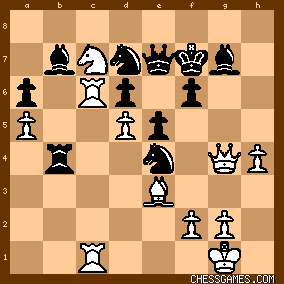
click for larger viewIf black takes the rook with 42...Bxc6, then 43 dxc6 double attacks the knight and creates a powerful passed pawn. 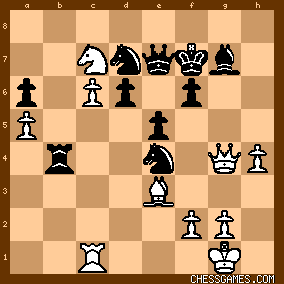
click for larger view |
|
| Aug-01-10 | | David2009: <Once: Fritzie reckons that the best defence for black is 41... Nf8 42. Bxc5 Rxe4 43. Rg3+ Rg4 44. Rxg4+ Bxg4 45. Qxg4+ Kh8 46. Be3 Rxc1+
47. Bxc1. The dust has settled, lots of material has been exchanged, the white mate threat has been replaced by a fairly healthy endgame advantage>
Crafty End Game Trainer agrees with Fritz that this is the best Black line, and continues 47...Qb7

click for larger view (Ponomariov vs Gyimesi 2005, best defence, 48?) Crafty EGT link: http://www.chessvideos.tv/endgame-t... I have tried and so far failed to win this against Crafty without outside (computer) help. My best effort was 49.Qxh7+ Kxh7 50.Ba3 Ng6 51.g3 Ne7 52.Bxd6 Nxd5 53.Kf1 Kg6 54.Ke2 e4 55.f3 f5 56.fxe4 fxe4 57.g4 Nf6 58.Ke3 Nxg4+ 59.Kxe4 Nf6+ 60.Ke5 Kf7 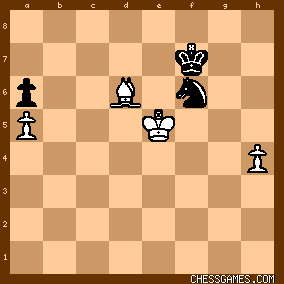
click for larger view
a position I have not managed to win. Can anyone else do better? |
|
| Aug-01-10 | | Jack Kerouac: Not necessarily insane, but somewhat demented.
Taking the bishop and not the rook led to visions of grandeur. |
|
| Aug-01-10 | | Marmot PFL: 40 Qh5+ Kg8 41 Nxg7 Qxg7 (Kxg7 42 Bh6+ and Rg3 wins) 42 Bh6 threatening Bxg7 or Rg3. 42...Nf8 43 Bxg7 Rxg7. I like white, Q+2P for 3 pieces, but black is not out of the game. That was the best I could find, but white improves on this, or at least gives black more room to go wrong. Looks like one of those games that usually win prizes. |
|
| Aug-01-10 | | bengalcat47: Spiders are very beneficial. When you think about it, that's a great way for a little blood-sucking mosquito to meet his demise! |
|
| Aug-01-10 | | Rob Morrison: All this analysis when it looks like 40. Nxg7!! is sound. This game raises my already high opinion of Ponomariov. In a position with black up two pieces and so many alternatives for white, RP shows remarkable coolness in just chopping that bishop on g7. It reminds me of Fischer's amazing 18. . . Nxg2!! in his famous 1963 win over Robert Byrne. |
|
| Aug-01-10 | | BOSTER: This puzzle should bigin at least from move 38. Amazing game playing by Pono. <CG> missed an essence. |
|
| Aug-01-10 | | James Bowman: Hmmm I'm always unsure of what the objective of the puzzles are, I suppose along the idea of the best line but often times you must guess play for both sides when it is not forced. The good news is this is rated 5 stars and intuitivly I chose the moves up until black resiged with in about a minute althought Qh5+ was my initially thought. I think any decsent player will notice the weekness of the king and start looking as how to best exploit this, so maybe 5 stars is a bit over rated 3 seems right to me. This is my first 5 star solution and so quick??? |
|
| Aug-01-10 | | David2009: <BOSTER: This puzzle should begin at least from move 38> Rewind to move 36:
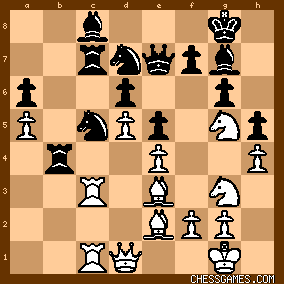
click for larger view
(Ponomariov vs Gyimesi 2005, 36?) The game continuation was 36.Nxh5 gxh5
37.Bxh5 f6 38.Bf7+ Kf8 39.Ne6+ Kxf7 to give the puzzle position. Insead,
Crafty End Game Trainer finds 39 ...Nxe6! 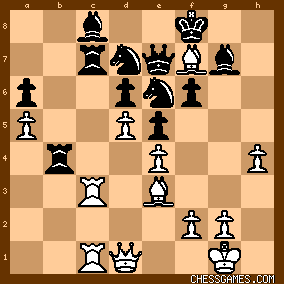
click for larger view
retaining a comfortable piece for two pawns in typical variations.
Crafty link to the position at move 36: http://www.chessvideos.tv/endgame-t... <Rob Morrison: All this analysis when it looks like 40. Nxg7!! is sound>
Crafty agrees with you! (see Ponomariov vs Z Gyimesi, 2005 Postscript - I finally found the White win.) |
|
| Aug-01-10 | | muralman: Hey, it's nice to get a Sunday puzzle without much trouble once in a while. Yeah, this was a lesson in controlling greed. I saw he night takes rook. But then I looked at the black bishop and saw interplay with my bishop and queen. Taking out the bishop uncomplicated things. Then, there was another tantalizer. The black queen was for the taking in an uncover check move by my bishop, but I had already spied the free rook, and that was checkmated territory. |
|
| Aug-01-10 | | Eduardo Leon: Not 40.♕h5+?! ♔g8 41.♘xg7 ♕xg7 42.♗h6 ♘f8! 43.♗xg7 ♖xg7, allowing black to create confusion. 40.♗h6?! looks impressive: 40...♔e8?? 41.♕h5+ ♕f7 42.♘xg7+ ♔f8 43.♘f5+ ♔g8 44.♖g3+,
or 40...♘xe6? 41.dxe6+ ♕xe6 42.♕h5+, and now both 42...♔g8 43.♗xg7 ♖xc3 44.♖xc3 ♔xg7 45.♖g3+ and 42...♔e7 43.♖xc7 ♗xh6 44.♖xc8 ♕f7 45.♕xh6 win quickly. <Continues> |
|
| Aug-01-10 | | Eduardo Leon: However, after 40...♗xh6, white has to be extremely precise to win: 41.♕h5+ ♔g8 42.♕xh6 (42.♖g3+? ♗g7 43.♘xg7 ♕xg7!) 42.♕xh6 ♕h7 43.♕xh7+ ♔xh7 44.♘xc7 ♘xe4 45.♘e8 ♘xc3 (45...♘dc5 46.♘xd6 ♘xd6 47.♖xc5 ♗b7 48.♖c7+ ♔g6 49.♖d7 ♘f5 50.♖cc7 ♗a8 51.♖a7 ♖b8 52.g3) 46.♖xc3 ♖xh4 47.♖xc8 ♔g6 48.♖c6 ♖d4 49.♖xa6 ♖xd5 50.♖xd6 ♖xd6 51.♘xd6. <Continues> |
|
| Aug-01-10 | | Eduardo Leon: White can deviate with 43.♖g3+?!, and, after 43...♔h8 44.♕xh7+ ♔xh7 45.♘xc7 ♘xe4 46.♘e8 ♖b8 (46...♘xg3? 47.hxg3 ♖b8 48.♖c7 ♗b7 49.♖xd7+ ♔g6 50.♘c7 ♖c8 51.g4) 47.♖g7+ ♔h6 48.♖c7 ♘ec5 49.f3 f5 50.h5 f4 51.h6, he achieves an impressive position. However, 51...♗b7! forces a liquidation: 52.♖cxd7 ♘xd7 53.♖xd7 ♖xe8 54.♖xb7 ♖c8!. Perhaps white is still winning, but I cannot tell the winning procedure. <Continues> |
|
| Aug-01-10 | | Eduardo Leon: White can avoid all the preceding complicated variations if he simply plays 40.♘xg7. If 40...♔xg7 41.♕h5, then 42.♗h6+ is unavoidable. And, if 40...♘f8 41.♕h5+ ♔g8 42.♘e8, then 42...♕f7 arrives one tempo too late: 43.♕xf7+ ♔xf7 44.♘xd6+ ♔(any) 45.♖xc5 ♖xc5 46.♗xc5 ♖(any) 47.♘xc8(+). |
|
| Aug-01-10 | | wals: Just prior to move 40, White has two pawns for a Bishop and Knight and an advantage of the equivalent of 2.21 pawns which must be because of positional strength and piece advantage. 40.Nxg7 opens up the kingside for the onslaught and increases the advantage to 3.05 pawns. Black's move, 41...Rxe4, +9.40 was the final nail in the coffin. RIP. courtesy of Rybka 3 1-cpu. |
|
| Aug-01-10 | | tivrfoa: nice sacrifices. real GM |
|
| Aug-01-10 | | SpoiltVictorianChild: I was thinking the inferior move order: Qh5+ Nxg7. Right idea though... Best I've done on a Sunday. :) |
|
Aug-01-10
 | | chessgames.com: We originally intended to use 36.Nxh5 as the Sunday puzzle but we couldn't get the computers to acknowledge that White has a distinct advantage after 39...Nxe6. |
|
| Aug-01-10 | | kengol: I thought 40.Bh6 was the winner but it seems that that 'combo' works in other move orders too ; all the elements are there. |
|
| Aug-02-10 | | TheBish: Ponomariov vs Z Gyimesi, 2005 White to play (40.?) "Insane"
It looks like White should win after 40. Qh5+ Kg8 41. Nxg7! (weakening the defense) and now White wins after either capture on g7: A) 41...Qxg7 42. Bh6 and Black can't save the queen and avoid mate, e.g. 42...Qh7 43. Qe8+ or 42...Qe7 43. Rg3+ Kh8 44. Be3+ Qh7 45. Qe8+ and mate in two. B) 41...Kxg7 42. Bh6+ Kh8 43. Rg3! and Black is helpless against the discovered check, i.e. 43...Qh7 44. Qe8+. Black's best may be 41...Rxe4 42. Nf5! and despite the piece deficit, White's attack is winning, e.g. 42...Qh7 43. Bh6 Nf8 44. Rg3+ Kh8 45. Qe8 Qf7 46. Nxd6! Qxe8 47. Nxe8 and White wins his piece back with interest (two pawns). Time to check it out. |
|
Aug-02-10
 | | OBIT: <chessgames.com: We originally intended to use 36.Nxh5 as the Sunday puzzle but we couldn't get the computers to acknowledge that White has a distinct advantage after 39...Nxe6.> Hmm, if 39...Nxe6 does not win, it comes tantalizingly close. After a few hours of work, this is my analysis: 39...Nxe6 40. dxe6! The threat is 40...Rxc7. Now if 40...Rxc3? 41. Rxc3 Nc5 42. Rxc5! dxc5 43. Bxc5 Rd4 (43...Qxc5?? 44. Qd8#) 44. Bxe7+ Kxe7 45. Qc2 leaves White with a big advantage. So, it appears 40...Rxc3 is not good. Black has to play 40...Nc5, and White plays 41. Rxc5. Now if 41...Rxc5? 42. Rxc5 Bxe6 43. Bxe6 Qxe6 (43...dxc5?? 44. Bxc5 Qxc5 45. Qd8# still works) 44. Rc6 with a big advantage to White. So, 41...Rxc5 can't be played. That leaves 41...dxc5 42. Bxc5 (apparently, 42. Rxc5 can be met by 42...Rc4) Rxc5 43. Rxc5. Now if 43...Bb7? 44. Qc2 Rd4 (to defend Rc8+; if 44...Qd8 45. Rc7 wins, the main threat being e7+) 45. Rc7 Qb4 46. Rc8+! Bxc8 47. Qxc8+ Ke7 48. Qe8+ Kd6 49. Qd7+ Kc5 50. Qc7+ Kb5 41. Be8+ and mate next move) So, 43...Bb7 seems to be inadequate. It appears Black has to play 43...Bxe6, when 44. Bxe6 Qxe6 45. Qd8+ follows. Now there are two possibilities: 45...Qe8 46. 46. Qd6+ Kg8 (46...Kf7? 47. Rc7+ followed by Qxb4; 46...Qe7? 47. Rc8+ Kf7 48. Rc7) 47. Qxa6 wins a third pawn and threatens Rc8. With three pawns for the piece, the Black bishop badly placed, and the a-pawn now looking very dangerous, I'd say White is clearly better. 45...Kf7 46. h5 threatens Rc7+. It appears 46...Rb7 is forced (not 46...Rc4 47. Qc7+ wins the rook), when White plays 47. Rc8. And, now doesn't Qg8+ Ke7 Re7 win? I think this analysis proves that White has a solid advantage at the very least. Of course, since I'm no GM, all this analysis is subject to review. It's too bad we're already into Monday and everyone has moved on to the next puzzle, else some other folks here might like to work on improving these lines. Also, what do the computers give as the main line? Where do they suggest different moves for Black? |
|
| Aug-02-10 | | C4gambit: Thanks <rapidcitychess> |
|
Aug-03-10
 | | OBIT: An update to my previous post.
Thanks, <David2009> for the link to this position on the Crafty End Game Trainer. Playing out the position from 39....Nxe6+, Crafty stays with my analysis up to 39...Nxe6 40. dxe6 Nc5. 41. Rxc5 dxc5 42. Bxc5 Rxc5 43. Rxc5 Bxe6 44. Bxe6 Qxe6 45. Qd8+. Here Crafty plays 45...Qe8, which is one of my two main lines. After 46. Qd6+ Kg8 47. Qxa6 I thought White is clearly better, but Crafty finds 47...Qh5!, which gives him good counterplay. In fact, his counterplay is so good I haven't been able to win this position. Using Crafty's moves, one line that leads to a draw is 48. Qc8+ Kh7 49. Rc4 Qd1+ (Crafty avoids 49...Rb1+ 50. Rc1, when the White rook may be able to get behind the a-pawn. However, 50...Rxc1+ 51. Qxc1 Qe2 52. Qc6 Qe1+ 53. Kh2 Qxf2 54. a6 leads to another draw, I think.) 50. Kh2 Rxc4 51. Qxc4 Qe1 52. Qc5 Qxe4 53. a6 (Another line I tried is 53. g3 Qd4!, when the only drawing continuation is 54. Qxd4 exd4 55. a6 d3 56. a7 d2 57. a8=Q d1=Q 58. Qe4+, escaping with a perpetual.) Qh4+ 54. Kg1 Qe4 55. a7 Qb1+ 56. Kh2 Qa2 57. Qb6 f5 58. Qb7 Qxf2 59. a8=Q Qh4+ and draws by perpetual check. Trying anything else that came to mind, one amusing line that led to a draw is 48. Qe3 Kh7!? (Don't know why Crafty avoids 48...Qxh4.) 49. Qc2 f5!? 50. ef Rxh4 51. f6+ Kh6 52. Qd2+ Kg6 53. Qd3+ Kh6 (53...Kxf6 54. Rc6+ leads to a perpetual) 54. Qd2+ Kg6, with yet another perpetual. Pretty much anything else I tried ended in defeat. It looks to me like this position really is a draw with best play. |
|
| Aug-05-10 | | patzer2: After analyzing the recent Sunday Aug 1, 2010 puzzle off and on for a few days, I've come to the conclusion White can win with either the expected 40. Nxc7!  , as preferred by <jimfromprovidence>, or the surprise attacking move 40. Nxg7!! as played by Ponomariov. , as preferred by <jimfromprovidence>, or the surprise attacking move 40. Nxg7!! as played by Ponomariov.In the game continuation, White's win looks stunningly brilliant in its conception but simple in its execution.
After 40. Nxg7! Kxg7 41. Qh5 Re4?! 42. Bh6+ Kh8 43. Re3  the threats against the exposed Black King are overwhelming. the threats against the exposed Black King are overwhelming. However, after the improvement 41...Nf8!, instead of 41...Rxe4?!, White's win is not so easy. Indeed, it becomes problematic enough that the alternative 40. Nxc7!  seems to offer just as strong a winning path. Even so, White must find some strong followup moves in both lines to assure the win. seems to offer just as strong a winning path. Even so, White must find some strong followup moves in both lines to assure the win. Here's some analysis using Fritz 10:
<40. Nxg7!!>
White eschews the simple win of what appears to be decisive material with 40. Nxc7!, choosing instead to remain temporarily down material for a strong attack on the exposed King. It's not an overly risky strategy, providing one can visualize the buildup of a rather straight forward King-side attack. The not so simple (as it first appears) alternative 40.Nxc7! wins after Fritz's best line 40...Kg8 41. Rc4! Rxc4 42. Rxc4 Nf8 43. Na8!  when play might continue 43...Nfd7 44. Nb6 Nxb6 45. axb6 Bf8 46. Qh5 Qf7 47. Qxf7+ Kxf7 48. g4 Bb7 49. f3 Be7 50. Kg2 Kg7 51. h5 Kf7 52. Rc1 Bf8
53. h6 when play might continue 43...Nfd7 44. Nb6 Nxb6 45. axb6 Bf8 46. Qh5 Qf7 47. Qxf7+ Kxf7 48. g4 Bb7 49. f3 Be7 50. Kg2 Kg7 51. h5 Kf7 52. Rc1 Bf8
53. h6 
<40... Kxg7 41. Qh5 Rxe4?!> On the surface this looks good, but in reality it makes White's task much easier. Putting up more resistance, but still losing to accurate followup is 41... Nf8! 42. Bxc5! Rxe4 43. Rg3+  , when play might continue 43...Rg4 44. Rxg4+ Bxg4 45. Qxg4+ Kh8 46. Be3 Rxc1+ 47. Bxc1 Qb7 48. h5 Qh7 (48... Qxd5 49. Bh6 Qg8 50. Qc8 Ne6 51. Qxa6 d5 52. Qb7 Qg4 53. Qf7 Nd4 54. Qxf6+ Kh7 55. f3 Qg3 56. Kf1 Nxf3 57. Qxf3 Qxf3+ 58. gxf3 , when play might continue 43...Rg4 44. Rxg4+ Bxg4 45. Qxg4+ Kh8 46. Be3 Rxc1+ 47. Bxc1 Qb7 48. h5 Qh7 (48... Qxd5 49. Bh6 Qg8 50. Qc8 Ne6 51. Qxa6 d5 52. Qb7 Qg4 53. Qf7 Nd4 54. Qxf6+ Kh7 55. f3 Qg3 56. Kf1 Nxf3 57. Qxf3 Qxf3+ 58. gxf3  ) 49. Ba3 Qc7 50. Kh2 Kh7 51. Qf5+ Kg7 52. h6+ Kf7 53. Qd3 Qc8 54. Bxd6 Ng6 55. Bb4 f5 56. Bd2 f4 57. d6 Qg4 58. g3 Qh5+ 59. Kg2 Qg4 60. d7 Nh4+ 61. Kg1 Nf3+ 62. Qxf3 Qxf3 63. d8=Q fxg3 64. Qd7+ Kf6 65. Be3 Qh5 66. Qc6+ Kf7 67. Qb7+ Ke6 68. fxg3 Qe2 69. Qc8+ Kf6 70. Qf8+ Ke6 71. Qg8+ Kd6 72. Bf2 e4 73. Qf8+ Kd7 74. Qf5+ Kd6 75. Qc5+ Ke6 76. h7 Qd1+ 77. Kh2 Qd8 78. Bd4 Qa8 79. Qe5+ Kd7 80. h8=Q ) 49. Ba3 Qc7 50. Kh2 Kh7 51. Qf5+ Kg7 52. h6+ Kf7 53. Qd3 Qc8 54. Bxd6 Ng6 55. Bb4 f5 56. Bd2 f4 57. d6 Qg4 58. g3 Qh5+ 59. Kg2 Qg4 60. d7 Nh4+ 61. Kg1 Nf3+ 62. Qxf3 Qxf3 63. d8=Q fxg3 64. Qd7+ Kf6 65. Be3 Qh5 66. Qc6+ Kf7 67. Qb7+ Ke6 68. fxg3 Qe2 69. Qc8+ Kf6 70. Qf8+ Ke6 71. Qg8+ Kd6 72. Bf2 e4 73. Qf8+ Kd7 74. Qf5+ Kd6 75. Qc5+ Ke6 76. h7 Qd1+ 77. Kh2 Qd8 78. Bd4 Qa8 79. Qe5+ Kd7 80. h8=Q  . . <42. Bh6+ Kh8>
Black gets mated after 42...Kg8 43. Rg3+ Kh8 44. Bf4+ Qh7 45. Qe8+ Nf8 46. Qxf8+ Qg8 47. Qxg8#. <Rg3> 1-0
Black resigns in lieu of White's clear mate threats, such as 43...Nf8 44. Bg7+ Kg8 45. Bxf8 Kxf8 46. Qh8+ Kf7 47. Rg7#. |
|
 |
 |
|
< Earlier Kibitzing · PAGE 3 OF 3 ·
Later Kibitzing> |





